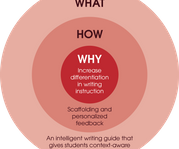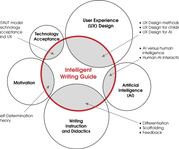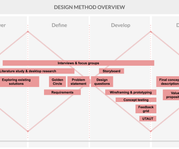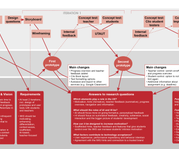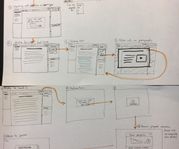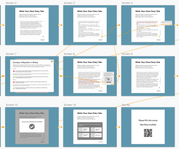Intelligent Writing Guide
Year
2019
Type of work
MSc Thesis
Collaborators
-
My role within the project
Concept development, prototyping, user testing, academic research
Methods
Sketch, Marvel, Adobe Illustrator, Adobe InDesign, focus groups, interviews, wireframing, storyboards, literature review, UTAUT, LaTeX
WHAT
For my master thesis, I designed the user experience for an Intelligent Writing Guide that helps students to improve their writing skills while supporting the teacher in enhancing differentiation in the classroom. The Intelligent Writing Guide is an AI-based tool that gives students context-aware hints during the writing process, scaffolding their learning process and prompting reflection rather than giving away the “right” answer. It is meant as a complementary tool that does not substitute, but supports the teacher.
My thesis itself focused on the conceptualization rather than the technical implementation of the tool and involved user research and multiple cycles of prototyping and testing with users. In my thesis, I bring together research insights from UX design, AI and education. Apart from creating the general UX design of the writing guide, I look at how AI and the teacher (human intelligence) can work together in a meaningful way, by taking a closer look at the strengths and weaknesses of both. In addition, I examine how the tool should be designed to be motivating for students to use, and I apply a technology acceptance model to it.
WHY
Teachers find it hard to differentiate in their teaching, because they lack insights about individual students’ progress and have little time to give individual feedback. Students need frequent feedback to develop and improve their writing skills. The Intelligent Writing Guide aims to support teachers in facilitating a participatory learning experience for students, rather than focusing on individualized learning where the teacher is no longer needed.
I did this project at Clio, a Danish EdTech company, that develops digital learning materials and educational technology for primary schools. My thesis was part of the Differentiation Project at the innovation department Clio Lab, focusing on how technologies like Artificial Intelligence can be used to increase differentiation in teaching.
THE PROCESS
I used the Double Diamond design framework to structure the project and alternate phases of divergent and convergent thinking. To gain an understanding of the problem and current practices of teachers and students in writing instruction, I conducted interviews with teachers and a focus group with students (8th grade). Here, I found out about the teachers’ lack of insight in students’ progress and the students’ need for more help during writing assignments. Through an extensive literature study and desktop research on state of the art, I deepened my knowledge about didactical concepts, designing for learning and AI.
With this foundation, I narrowed down the problem and created a list of requirements for the solution, specifying that the solution would focus on giving feedback on text type characteristics, rather than grammar and spelling. I visualized this idea in a storyboard to get feedback from the Clio team, which I then used to sketch simple wireframes that served as a basis for the first lo-fi prototype I made in Sketch. The first prototype focused on communicating the concept that students get continuous feedback that was presented in multiple layers, according to the student’s need. Concept tests that I arranged with a teacher and a group of students revealed that they perceived the concept as useful, provided that some crucial features, such as a progress overview for the teacher, would be added.
Taking into account the user feedback and new ideas from a brainstorm session, I made a new iteration of the prototype. I designed the interface of this to be consistent with other existing Clio products. Again, I went out to students and teachers to test my prototype and gather feedback on the concept. Overall, they were very positive about the concept and the different features it offers. With the feedback in mind, I created a final prototype that visualized the concept with its main functionalities. Due to lack of time, the prototype was not further developed into a technically functional prototype.
OUTCOME & EVALUATION
The final prototype I created is an example of what the Intelligent Writing Guide could look and work like. While the user feedback on the prototype was very positive, it only says little about if and how users would actually use the Intelligent Writing Guide in the classroom. Therefore, the next step would be to develop a technically functional prototype that can be tested in the real context of writing instruction.
From a UX perspective, the Intelligent Writing Guide fits well within the product portfolio and architecture of Clio, using Semantic UI elements and following their design guidelines. It offers a clear and easily-understandable interface that communicates the concept of the Intelligent Writing Guide to the user. The design process approached and solved the initial problem holistically, combining insights from different disciplines. It included frequent user involvement and several rounds of iteration to improve the prototype incrementally.
After completion of my project, I was invited to present my thesis work at the LearnT Conference 2019 and as a lecture for the course Digital Learning Technology and Entrepreneurship in September 2019 at the Technical University of Denmark (DTU).You can find a presentation of my thesis here. If you want to read my thesis, feel free to contact me.

